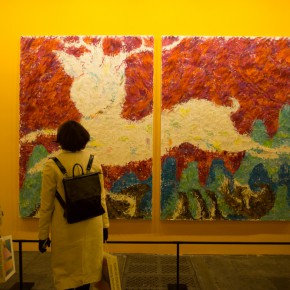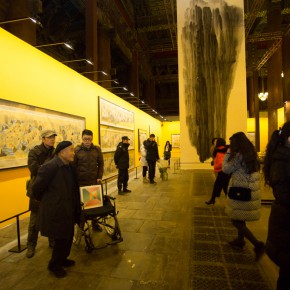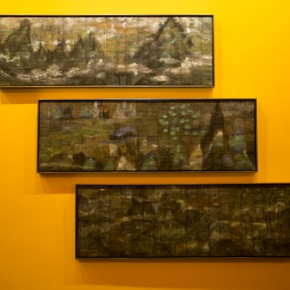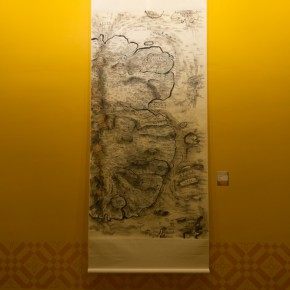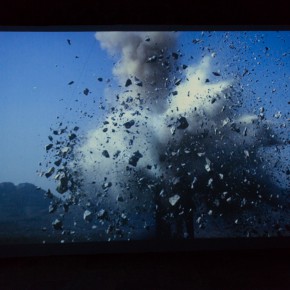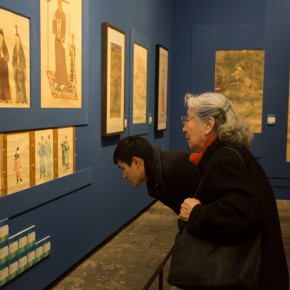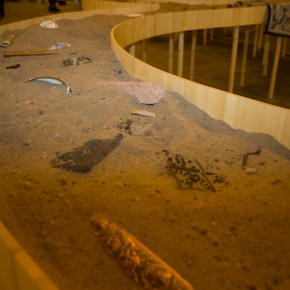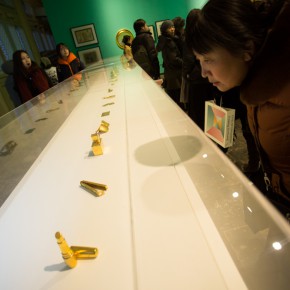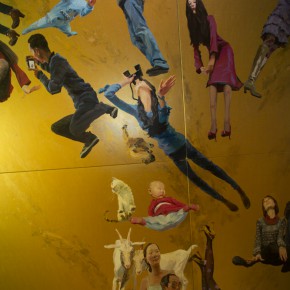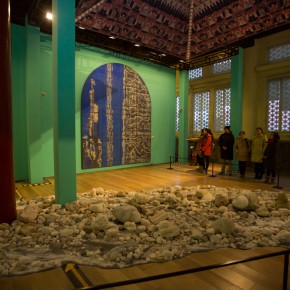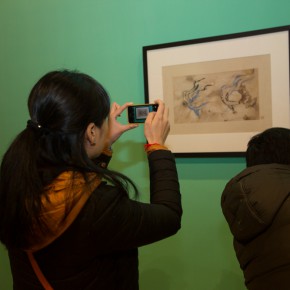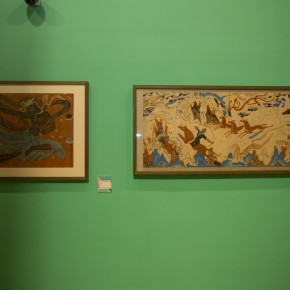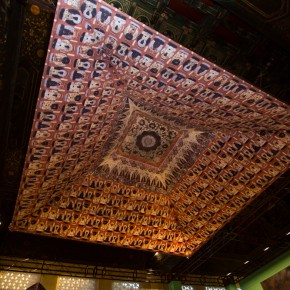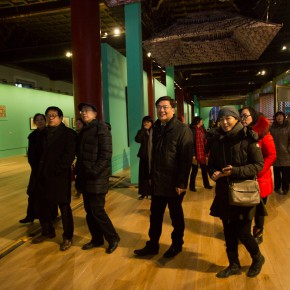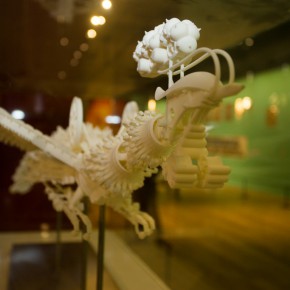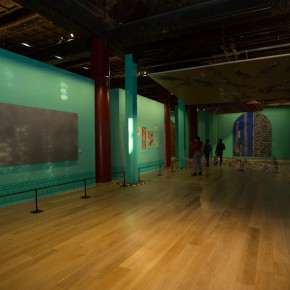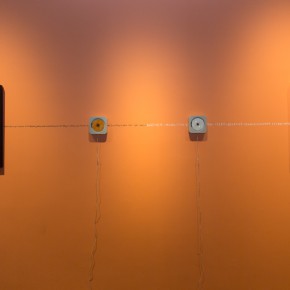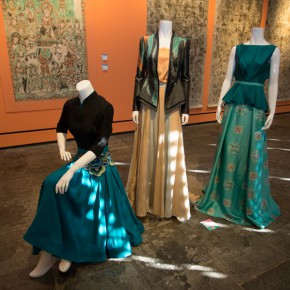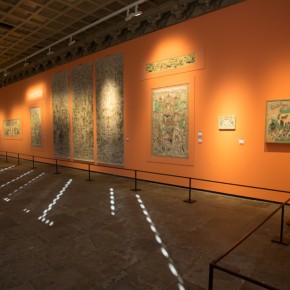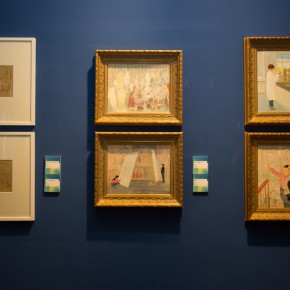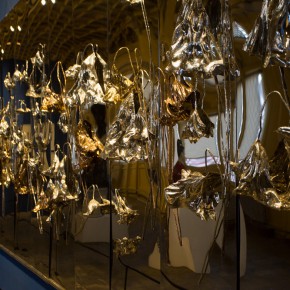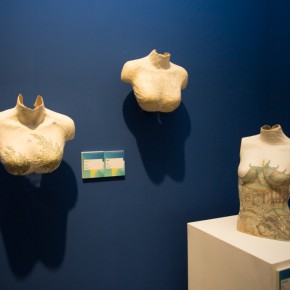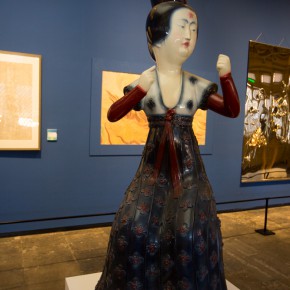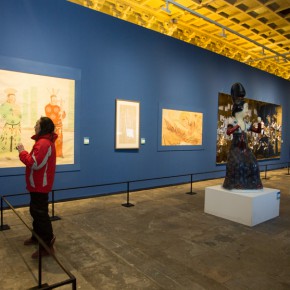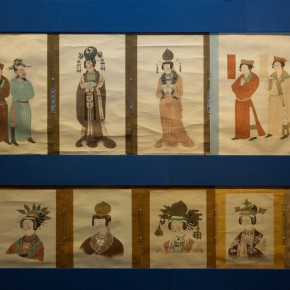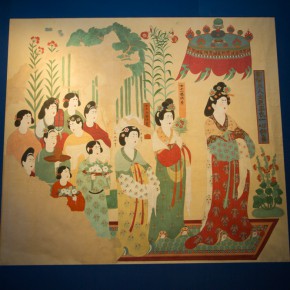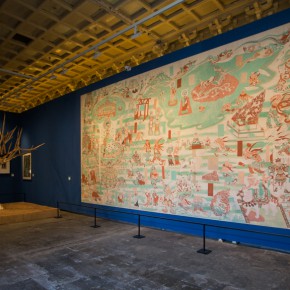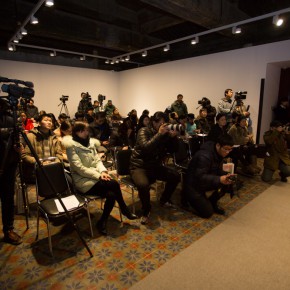
Under the strategic framework of the “China-proposed Belt and Road Initiative”, the China Central Academy of Fine Arts together with Beijing Municipal Federation of Trade Unions and Dunhuang Academy, jointly launched the large-scale exhibition “Crossing Dunhuang” on the occasion of the Spring Festival in 2016. In the first section of “ECHO of CIVILIZATION”, the exhibition takes Dunhuang as the starting point, paying attention to this treasure house in this boundless desert. It intends to contrast the classics of traditional art with the innovations of contemporary art, experiencing the rich heritage of traditional cultures while expanding relationships between local traditional cultural resources and contemporary art creations. The art works for this exhibition are composed of three parts: the most representative copied works of Dunhuang Art in the Wei-Jin Dynasties and Yuan Dynasty provided by Dunhuang Academy; classic copied works by generations of fine arts masters collected by the Central Academy of Fine Arts; polymorphic works by contemporary artists and designers inspired by “Dunhuang”. The exhibition includes four chapters: “Open a Way to the West”, “Flying Asparas”, “Ceremony and Music Rituals” and “Worshipping”, through over 300 works to construct a dialogue between the ancient and modern.
Open a Way to the West: the Extension of “Space” and “Time” on the Silk Road
Ever since Zhang Qian opened a way to the west in the Xihan Dynasty, the gap between the East and the West has gradually been unfolded. Dunhuang is situated at the opening of the road connecting the East and the West, has gradually become the center of commercial and cultural crossroads. For thousands of years, the merchant caravans, cultural ambassadors flocked here and they gave birth to the splendid culture of Dunhuang represented by the Mogao Grottoes.
The road in “Silk Road” refers not only to the road of space, but it also stands for the space of time. Taking “Opening a Way to the West” as its title, this chapter intends to reflect the intersection and extension of the “road” and the broadband and infinity of space. In this chapter, the copying works of ancient murals provided by Dunhuang Academy together with the liberal copying and sketches by modern masters of art such as Dong Xiwen, Ye Qianyu, Zhan Jianjun and Wu Zuoren, faithfully reproducing the commercial and cultural exchanges on the ancient Silk Road and reflecting the profound sense of Buddhist art; on the other hand, from a variety of artistic expressions, artists such as Xu Longsen, Ding Fang, Zhan Wang, Jin Rilong, Wang Gang, Zhang Yanzi “reshaped” the birth of the Universe and landscapes. Xie Zhenou, Qiu Zhijie, Liu Jia, Yu Fan and other artists depicted the cultural exchanges in Dunhuang and on the Silk Road, as well as the contemporary scenes of Mogao Grottoes; Wu Yi, Wu Jian’an, Xiang Jing and Yang Huishan interpreted various motifs, on the stories of Buddha Jataka, etc. Contemporary artists deliberate and visually reflect the world over thousands of years, interpreting the concept of “Opening a Way to the West” with contemporary cultural concepts and rich artistic languages.
Flying Asparas: Romantic Imagination Flying in the Sky
In both Eastern and Western cultures, there is an image that can fly in the sky, a western angel, with life-sized wings, is a special messenger that convey the will of God, while a feathered man in China is a god who guides people to ascend to heaven and be immortal. “Flying Asparas” usually seen in the Dunhuang frescoes comes from the ancient Indian mythology, and they are integrated with Chinese Taoist culture. With a long dance band, they soar into the sky.
In the chapter of “Flying Asparas”, the classic murals and copied works of the caisson ceiling provided by Dunhuang Academy, presents the fusion and evolution of the “Flying Asparas” in the image, gesture as well as mood, taste, forms and styles since they have been introduced into China. The senior generation of artists such as Dai Ze, Lu Hongnian, Deng Bai concentrated on the expressive passion in their copying of Flying Asparas and they provided an intuitive presentation to the scheme of Dunhuang Flying Asparas. Contemporary artists such as Xu Bing, Chen Hongzhi, Li Tianyuan and so on, from the contemporary perspective, transformed the viewing modes of caisson and the visual features of Flying Asparas into the key elements of their artistic creation; Jiang Dahai, Yu Hong, Hu Mingzhe, Wang Guangle and so on, conveyed their understanding and reinterpretation of this classic image into the method of material experiments and creative methodology research. The involvement of contemporary cultural issues further expanded the conventional concepts of “Flying Asparas” as formal elements, and they endowed the modeling of ancient flying asparas with a visual representation containing contemporary multicultural landscapes.
Ceremony and Music Rituals: Buddhist Sounds and Elegant Music should only be heard in heaven
The emergence of a large number of music and dance murals in the Dunhuang Grottoes, showcase romantic artistic imaginations, they are the resource treasure of images in the magnificent history of ancient musical instruments and the history of dance. Also, they have witnessed the interaction and mutual development of cultural traditions of ceremonial music between China and the West, further they communicate the relationship between religions and secular fashions. In this chapter, Liu Lingcang, Chang Shana, Xiao Shufang and other modern masters reinterpret the traditional ceremonial music in an artistic way for large-scale creations, reflecting the cultural choices featured by the epoch; contemporary art works from the dimensions of “ceremony” and “music rituals that present a stereoscopic interpretation, on the one hand, there are deduction of stories on scriptures, books and silk books, developments of scriptures from Shi Jinsong and Wang Lei; on the other hand, Wang Dongling, Li Hongbo plus others on the refined abstract expressions of the dance gestures and contents, in a variety of styles, they extracted and developed the rhythms, scenes and atmospheres, also Tan Dun’s music masterpiece, from various angels presents a connotation of contemporary culture with “ceremony and music rituals”.
Worshipping: Buddha and Sentient Beings, Faith and Worship
There are a large number of images portraying worshiping supporters in Dunhuang frescoes, from emperors, generals, ministers, to a lord of clerical temples to the mass, all were left with their images on the murals, which provides a history of Chinese ancient portraits, endowed the religious belief with a fresh breath of life. In this chapter, Sun Zongwei, Wu Wei, Sun Jingbo and other masters portrayed the images from heaven to the mortal with superb artistry, they presented their interpretation of ancient modeling, and their aesthetic features were subtly reflected in the works. Lv Yue, Chu Yan, Peng Wei, Zhang Fan and other contemporary artists, whether ingenuious in designing clothes, or in gold jewelry, they use a variety of mediums and contemporary design language means to combine traditional patterns, classical cultural heritage and contemporary cultural appearances; Chen Zhiguang, Li Yi, Ai Jing and so on presented the motif of worship from the perspective of material installation, the objects of their interpretations are no longer the Buddha of Zen and Enlightenment, but the time, life and art, containing the philosophical meaning of endless recycles of lives.
Photo by Yan Yanyuan, text edited by Zhang Wenzhi/CAFA ART INFO
Translated and edited by Sue/CAFA ART INFO
Artists:
1. Copying Section: (Alphabetical order by last name)
Chang Shuhong, Chang Shana, Dai Ze, Deng Bai, Dong Xiwen, Duan Wenjie, Fan Wenzao, Fan Xinggang, Fang Zengxian, Feng Zhongnian, Gao Ertai, Gao Peng, Gao Shan, Guan Jinwen, Guan Youhui, Guo Shiqing, He Zhizhao, Hua Liang, Huo Xiufeng, Huo Xiliang, Jiang Hao, Li Yunhe, Li Yuebo, Li Bingling, Li Xiuhua, Li Qiqiong, Li Chengxian, Li Fu, Li Zhenfu, Liu Yuquan, Liu Boshu, Ling Lingcang, Lou Jie, Lu Hongnian, Ma Yuhua, Ma Qiang, Ouyang Lin, Shi Weixiang, Shao Hongjiang, Shen Shuping, Sun Jingbo, Sun Zongwei, Wan Gengyu, Wu Rongjian, Wu Wei, Wu Zuoren, Xiao Shufang, Yang Tongle, Ye Qianyu, Zhan Jianjun, Zhang Ding, Zhao Junrong, Zhong Yiqiu;
The First Studio Students from the Mural Department, Plastic Arts School of the Central Academy of Fine Arts, Teachers and Students from the Senior Researching Class of Mineral Rock Painting, CAFA;
2.The Contemporary Section ( in alphabetical order of surname)
Ai Jing, Chen Hongzhi, Chen Zhiguang, Chu Yan, Ding Fang, Feng Yang, Hu Mingzhe, Jiang Dahai, Jin Zhilong, Li Hongbo, Li Yi, Li Tianyuan, Li Xiaodan, Liu Jia, Lv Yue, Peng Wei, Qiu Zhijie, Shi Jinsong, Sun Bo, Tan Dun, Wang Dongling, Wang Guangle, Wang Gang, Wang Lei, Wang Peng, Wu Jian’an, Wu Yi, Xiang Jing, Xie Zhenou, Xu Bing, Xu Longsen, Yang Huishan, Yu Fan, Yu Hong, Zhan Wang, Zhang Fan, Zhang Yanzi.




